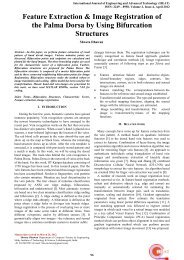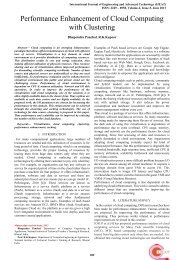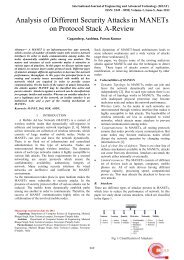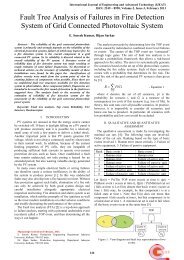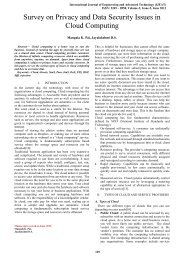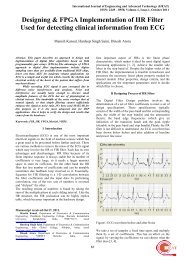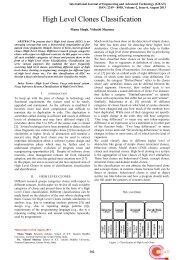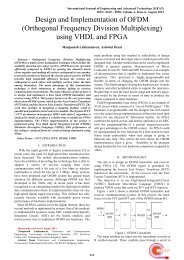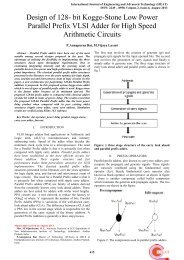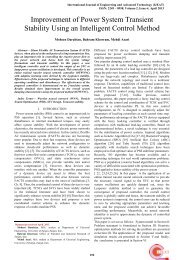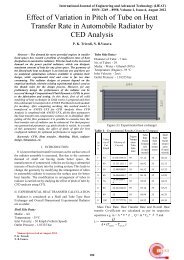Algorithm for Face Matching Using Normalized Cross-Correlation
Algorithm for Face Matching Using Normalized Cross-Correlation
Algorithm for Face Matching Using Normalized Cross-Correlation
You also want an ePaper? Increase the reach of your titles
YUMPU automatically turns print PDFs into web optimized ePapers that Google loves.
<strong>Algorithm</strong> For <strong>Face</strong> <strong>Matching</strong> <strong>Using</strong> <strong>Normalized</strong> <strong>Cross</strong>-<strong>Correlation</strong>be employed to skip unnecessary calculation. Experimentalresults showed the proposed algorithm has very efficient <strong>for</strong>image matching under different lighting conditions.In [1], the author has proposed a combined approach toenhance the per<strong>for</strong>mance of template matching system usingimage pyramid in conjunction with Sum of AbsoluteDifference (SAD) similarity measure. Based on results it wasfound that the capabilities provided by the proposed methodsignificantly improved the accuracy and execution time oftemplate matching system. The experimental investigationswere based on the use of color and gray scale images withdifferent sizes and illumination.The paper [5] has presented a robust and efficient matchingmethod <strong>for</strong> face sequences obtained from videos. <strong>Face</strong>in<strong>for</strong>mation is quite important especially <strong>for</strong> news programs,dramas, and movies. <strong>Face</strong> sequence matching <strong>for</strong> such videosenables many multimedia applications including contentbased face retrieval, automated face annotation, automatedvideo authoring, etc. However, face sequences in videos aresubject to variation in lighting condition, pose, faceexpression, etc., which cause difficulty in face matching.These problems were tackled to achieve robust face sequencematching applicable to real video domains, and its efficientimplementation is presented. The paper proved the proposedmethod achieves good per<strong>for</strong>mance in actual video domains.In addition, by the combination with the high dimensionalindex structure, the algorithm achieved practicalcomputational time, as well as scalability against increase ofthe number of faces.In [6], the authors have presented a review of recent as well asclassic image registration methods in paper ―Imageregistrations method: A survey‖. The reviewed approacheswere classified according to their nature (area based andfeature-based) and according to four basic steps of imageregistration procedure: feature detection, feature matching,mapping function design, and image trans<strong>for</strong>mation andresampling. Main contributions, advantages, and drawbacksof the methods were mentioned in the paper. Problematicissues of image registration and outlook <strong>for</strong> the futureresearch were discussed too. The major goal of the paper wasto provide a comprehensive reference source <strong>for</strong> theresearchers involved in image registration, regardless ofparticular application areas.From the review of literature it is observed that thetemplate matching algorithm based on <strong>Normalized</strong><strong>Cross</strong>-<strong>Correlation</strong> is the best approach <strong>for</strong> matching thetemplate with same image accurately. In this paper weproposed a face matching algorithm based on <strong>Normalized</strong><strong>Cross</strong>-<strong>Correlation</strong> and used to matching the extracted face ofthe person from one image, with the different images of sameperson. The rest of this paper is organized as follows. Wedescribe the proposed face matching algorithm in the nextsection. We show some experimental results in section 5,finally, we conclude in the last section.III. CROSS-CORRELATION<strong>Correlation</strong> is an important tool in image processing, patternrecognition, and other fields. The use of cross-correlation <strong>for</strong>template matching is motivated by the distance measure(squared Euclidean distance) [8], [9]Where f is the target image and t is the feature, the sum isover x,y under the window containing the feature t positionedat( u, v). In the expansion of d 2(1)+ (2)The term is constant. If theterm is approximately constant, then the remainingcross-correlation termis a measure of the similarity between the image and thefeature.<strong>Normalized</strong> <strong>Cross</strong>-<strong>Correlation</strong>There are several disadvantages to using (3) <strong>for</strong> templatematching:(3) If the image energy varies with position,matching using (3) can fail. For example, thecorrelation between the feature and an exactlymatching region in the image may be less than thecorrelation between the feature and a bright spot.The range of c(u, v) is dependent on the size of thefeature.Eq. (1) is not invariant to changes in imageamplitude such as those caused by changing lightingconditions across the image sequence.The correlation coefficient overcomes these difficulties bynormalizing the image and feature vectors to unit length,yielding a cosine-like correlation coefficientWhere is the mean of the feature and is the meanof f(x, y) in the region under the feature. We refer to (4)as <strong>Normalized</strong> <strong>Cross</strong>-<strong>Correlation</strong>.(4)IV. PROPOSED FACE MATCHING TECHNIQUE<strong>Face</strong> matching system involved 2 stages of operation (1): Firststage is the model registration which is931



